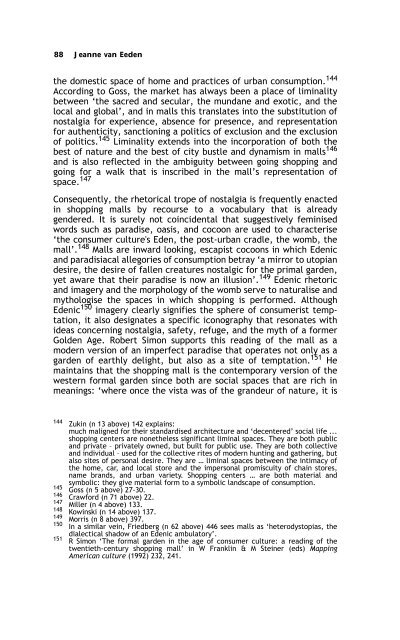Sex, Gender, Becoming - PULP
Sex, Gender, Becoming - PULP
Sex, Gender, Becoming - PULP
You also want an ePaper? Increase the reach of your titles
YUMPU automatically turns print PDFs into web optimized ePapers that Google loves.
88 Jeanne van Eeden<br />
the domestic space of home and practices of urban consumption. 144<br />
According to Goss, the market has always been a place of liminality<br />
between ‘the sacred and secular, the mundane and exotic, and the<br />
local and global’, and in malls this translates into the substitution of<br />
nostalgia for experience, absence for presence, and representation<br />
for authenticity, sanctioning a politics of exclusion and the exclusion<br />
of politics. 145 Liminality extends into the incorporation of both the<br />
best of nature and the best of city bustle and dynamism in malls 146<br />
and is also reflected in the ambiguity between going shopping and<br />
going for a walk that is inscribed in the mall’s representation of<br />
space. 147<br />
Consequently, the rhetorical trope of nostalgia is frequently enacted<br />
in shopping malls by recourse to a vocabulary that is already<br />
gendered. It is surely not coincidental that suggestively feminised<br />
words such as paradise, oasis, and cocoon are used to characterise<br />
‘the consumer culture's Eden, the post-urban cradle, the womb, the<br />
mall’. 148 Malls are inward looking, escapist cocoons in which Edenic<br />
and paradisiacal allegories of consumption betray ‘a mirror to utopian<br />
desire, the desire of fallen creatures nostalgic for the primal garden,<br />
yet aware that their paradise is now an illusion’. 149 Edenic rhetoric<br />
and imagery and the morphology of the womb serve to naturalise and<br />
mythologise the spaces in which shopping is performed. Although<br />
Edenic 150 imagery clearly signifies the sphere of consumerist temptation,<br />
it also designates a specific iconography that resonates with<br />
ideas concerning nostalgia, safety, refuge, and the myth of a former<br />
Golden Age. Robert Simon supports this reading of the mall as a<br />
modern version of an imperfect paradise that operates not only as a<br />
garden of earthly delight, but also as a site of temptation. 151 He<br />
maintains that the shopping mall is the contemporary version of the<br />
western formal garden since both are social spaces that are rich in<br />
meanings: ‘where once the vista was of the grandeur of nature, it is<br />
144 Zukin (n 13 above) 142 explains:<br />
much maligned for their standardised architecture and ‘decentered’ social life ...<br />
shopping centers are nonetheless significant liminal spaces. They are both public<br />
and private – privately owned, but built for public use. They are both collective<br />
and individual – used for the collective rites of modern hunting and gathering, but<br />
also sites of personal desire. They are … liminal spaces between the intimacy of<br />
the home, car, and local store and the impersonal promiscuity of chain stores,<br />
name brands, and urban variety. Shopping centers … are both material and<br />
symbolic: they give material form to a symbolic landscape of consumption.<br />
145 Goss (n 5 above) 27-30.<br />
146 Crawford (n 71 above) 22.<br />
147<br />
Miller (n 4 above) 133.<br />
148 Kowinski (n 14 above) 137.<br />
149 Morris (n 8 above) 397.<br />
150<br />
In a similar vein, Friedberg (n 62 above) 446 sees malls as ‘heterodystopias, the<br />
dialectical shadow of an Edenic ambulatory’.<br />
151 R Simon ‘The formal garden in the age of consumer culture: a reading of the<br />
twentieth-century shopping mall’ in W Franklin & M Steiner (eds) Mapping<br />
American culture (1992) 232, 241.
















